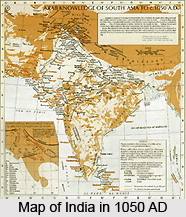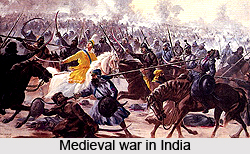 It was in the 5th to 7th centuries the Muslim conquest in the Indian subcontinent took place. Change was witnessed in almost every sphere. Indian Admisistration, Social life, religion and even in the culture of India, cuisine and art a colossal influence of Islam was witnessed.
It was in the 5th to 7th centuries the Muslim conquest in the Indian subcontinent took place. Change was witnessed in almost every sphere. Indian Admisistration, Social life, religion and even in the culture of India, cuisine and art a colossal influence of Islam was witnessed.
Effects on Administration: The Sultan of Delhi was an autocrat. He was bound by no law, and was subject to ministerial check. He was guided by no one except his own. The people had no rights and they had to carry out his commands. Very little was achieved in the administrative field. For establishing peace the rulers had to contend not only against the Hindus who formed the resistant elements, but also they had to be in constant conflict with their own Amirs or Military Chiefs whom they appointed as governors of the various administrative divisions. But in the revenue department the Sultans had to depend mostly on the local machinery, as they had no trained staff to do the work of assessment and collection. Administration of the villages during this period continued to be carried by the more or less autonomous panchayats.
Babur and Humayun continued the administrative arrangements of the Sultanate period. But Sher Shah clearly defined the territorial limits of the subahs. He established a uniform system of administration throughout his dominions except for Multan and Bengal. Similarly Sher Shah`s Revenue System formed the basis of the system introduced during Akbar`s reign. His policy of toleration towards the Hindus also contributed to the success of his administration. He never debarred them from civil or else military service. The administrative policy and reforms formed the basis for the efficient and progressive government and administrative machinery developed by Akbar. Akbar did away entirely with one all-powerful Wazir and divided his powers and functions among four ministers of nearly equal power, rank and status. He divided his empire into twelve subahs. The subahs were further divided into sarkars and parganahs. A judicious fiscal policy was initiated and to conciliate the large non-Muslim population, religious taxes such as pilgrim`s tax and jizyah were abolished. Currency was also placed on a sound footing. With the establishment of peace and prosperity through efficient administrative machinery, there was a great development in the educational and cultural fields. The developments usually include art and architecture.
Jahangir did not make any material changes in the system of administration, but both finance and general administration deteriorated to such an extent during his regime that his successor Shahjahan, was largely occupied in restoring stability and efficiency.
The destructive forces had begun to undermine the edifice of the Mughal Empire during Shahjahan`s regime. This happened due to his intolerance in religion gained increased momentum. Aurangzeb`s abrogation of Akbar`s policy of religious toleration transformed India into a strictly Islamic state. His discriminatory fiscal policy and methods of administration of justice were responsible for ever-increasing resistance on the part of the Marathas, Rajputs, Bundelas, Jats and Sikhs. These places developed into formidable powers and were in no small measure responsible for the downfall of the Mughal Empire in later days.
 According to the historians there was Mughal rule from past two hundred years from the accession of Akbar to the death of Muhammad Shah in the year of 1556-1749. This rule gave the whole of northern India and much of the Deccan some unique thoughts and these can be mentioned as oneness of official language, administrative system and coinage.
According to the historians there was Mughal rule from past two hundred years from the accession of Akbar to the death of Muhammad Shah in the year of 1556-1749. This rule gave the whole of northern India and much of the Deccan some unique thoughts and these can be mentioned as oneness of official language, administrative system and coinage.
Effect on Social Life
Muslim rulers such as Alauddin, Firoz Tughlaq and Sikandar Lodi caused great persecution of the Hindus and inflicted many cruelties and injustices on them. Only Muslims were appointed on the high administrative posts at that time. The Hindus were not allowed to worship openly. They were discriminated in every matter and were considered inferior to Muslims. The Jazia tax was imposed on the Hindus. Originally, Brahmanas were exempted from paying this tax but Sultan Firoz Tughlaq imposed this tax upon them also. The Sultans hoped that the discriminatory treatment and economic pressure would make the bulk of the Hindus embrace Islam but this wish of theirs was not fulfilled at any point of time.
However, both Hindus and Muslims changed a lot because of the close contacts between the two over such a long period. This also brought changes in their social lives. The idea of the brotherhood of Islam and equality of its adherents had a powerful appeal for the low cases among the Hindus who were looked down upon by the people of high castes and there were large-scale conversions especially in Bengal. Islam minimized the importance of birth and heredity and its influence quickened in Hinduism the feelings of social equality and brotherhood.
Effect on Hindu Caste System
The immediate result of the Muslim conquest was the rigidity of the caste system. Caste rules were framed in such a way that no loophole was left for any intrusion by outsiders who were declared Mlechchhas or untouchables at that time. But in the long run the Islamic ideas of brotherhood and equality tended to break these barriers through the teachings of religious reformers like Ramanand, Kabir, Chaitanya, Nanak, Dadu and others.
Effect on the Position of Women
In the royal harems of Hindu rulers, the Pardah system was rigidly enforced. The queens of Raja Rudra Pratap of Puri used to visit Chaitanya in covered palanquins. Akbar issued orders that young women should always move out only in Pardah.
The evil practice of child infanticide also started due to the influence of the Muslims. Child marriage of the Hindu girls became prevalent to avoid their kidnapping by the Muslims.
Effect on Slavery
Muslim rulers used to keep men and women as slaves. Alauddin Khilji had as many as 84,000 slaves. As a result of contact with the Muslim rulers the Hindu rulers also began to appoint a large number of male and female slaves in their palaces and the condition of slaves also deteriorated in this period.
Effect on Dress and Amusements
 Muslim villager of Bihar or Bengal or Punjab or U.P. wears a dress, which is indistinguishable from that of his Hindu compatriot. The pyjamas are worn by a majority of Muslims but the Hindus also wear pyjamas. The ornaments worn by women are common to both communities. Undoubtedly Achkan and Salwar owe their introduction to Muslim influence but many Hindus also wear these clothes.
Muslim villager of Bihar or Bengal or Punjab or U.P. wears a dress, which is indistinguishable from that of his Hindu compatriot. The pyjamas are worn by a majority of Muslims but the Hindus also wear pyjamas. The ornaments worn by women are common to both communities. Undoubtedly Achkan and Salwar owe their introduction to Muslim influence but many Hindus also wear these clothes.
Hunting, hawking, chaughan (polo) and many other games became Mohammadanized in form and technique.
Effect on Gardening
In gardening the Mughal rulers contributed to developing a sense of balance, harmony and precision. Many Hindu rulers imitated the plan of these gardens. Mughals were great lover of flowers and gardens and this habit was also transmitted to many Hindus.
Effect on Food
The Muslims were accustomed to sumptuous dinners and sometimes as many as 100 dishes were served on their table. There is no doubt that many new preparations were introduced in Indian diet as a result of the contact of the Hindus with the Muslims.
Effect on Indian Economy
Change came in the arena of Indian economy. Trade developed. An important result of the advent of Islam was the restoration of contact with the outside world. Hundreds of traders from Bukhara and Samarkand, Balkh and Khurasan, Khwarizm and Persia and also travelers from Europe poured into India. The Mughal government facilitated and fostered commercial relations with European nations and also allowed them to establish their factories in coastal towns. This resulted not only in commercial contacts but also in an exchange of ideas, customs, and traditions and even led to a quickening of contemporary local thought. During the two hundred years of Mughal rule towns and cities prospered while the peasants in the villages suffered from excessive taxation and from oppressive measures of collection. They were often compelled to abandon the country and seek a more tolerable mode of existence in the towns. In the imperial karkhanas luxury goods of great value and beauty were produced but the workers were often paid low wages.
Effects on Education and Learning
The famous universities and centers of learning had grown stagnant before the advent of the Muslim rule. The Muslim conquerors introduced a new system of education through the media of Arabic and Persian but in spite of the establishment of a large number of madrasas they served only a small section of the people. The non-Muslim majority was not admitted to these institutions. It was only during Sikandar Lodi`s rule that the Hindus connected with the courts of Muslim rulers commenced to study Persian literature.



















